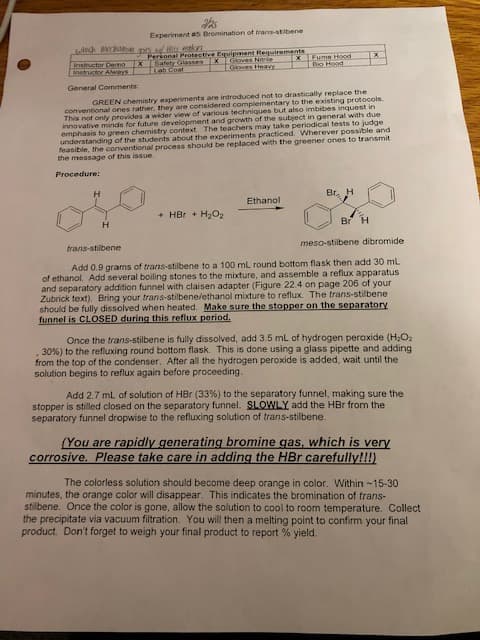Experiment as Bromination of trans-stibene Instructor Demo Instructor Always Personal Protective Equipment Requirements Safety Glases XGoves Nre Lab Coat Fume Hood Bo Hood EGioves Heavy General Comments conventional ones rather, they are considered complementary to the existing protocols. This not only provides a wider view of various techniques but also imbibes inquest in innovative minds for future development and growth of the subject in general with due emphasis to green chemistry context The teachers may take periodical tests to judge understanding of the students about the experiments practiced. Wherever possible and feasible, the conventional process should be replaced with the greener ones to transmit the message of this issue GREEN chemistry experiments are introduced not to drastically replace the Procedure: Br. H Ethanol + HBr + H2O2 H. Br trans-stilbene meso-stilbene dibromide Add 0.9 grams of trans-stilbene to a 100 mL round bottom flask then add 30 ml of ethanol. Add several boiling stones to the mixture, and assemble a reflux apparatus and separatory addition funnel with claisen adapter (Figure 22.4 on page 206 of your Zubrick text). Bring your trans-stilbene/ethanol mixture to reflux. The trans-stilbene should be fully dissolved when heated. Make sure the stopper on the separatory funnel is CLOSED during this reflux period. Once the trans-stilbene is fully dissolved, add 3.5 ml of hydrogen peroxide (H,O2 30%) to the refluxing round bottom flask. This is done using a glass pipette and adding from the top of the condenser. After all the hydrogen peroxide is added, wait until the solution begins to reflux again before proceeding. Add 2.7 ml of solution of HBr (33%) to the separatory funnel, making sure the stopper is stilled closed on the separatory funnel. SLOWLY add the HBr from the separatory funnel dropwise to the refluxing solution of trans-stilbene. (You are rapidly generating bromine gas, which is very corrosive. Please take care in adding the HBr carefully!!!) The colorless solution should become deep orange in color. Within -15-30 minutes, the orange color will disappear. This indicates the bromination of trans- stilbene. Once the color is gone, allow the solution to cool to room temperature. Collect the precipitate via vacuum filtration. You will then a melting point to confirm your final product. Don't forget to weigh your final product to report % yield.
Reactive Intermediates
In chemistry, reactive intermediates are termed as short-lived, highly reactive atoms with high energy. They rapidly transform into stable particles during a chemical reaction. In specific cases, by means of matrix isolation and at low-temperature reactive intermediates can be isolated.
Hydride Shift
A hydride shift is a rearrangement of a hydrogen atom in a carbocation that occurs to make the molecule more stable. In organic chemistry, rearrangement of the carbocation is very easily seen. This rearrangement can be because of the movement of a carbocation to attain stability in the compound. Such structural reorganization movement is called a shift within molecules. After the shifting of carbocation over the different carbon then they form structural isomers of the previous existing molecule.
Vinylic Carbocation
A carbocation where the positive charge is on the alkene carbon is known as the vinyl carbocation or vinyl cation. The empirical formula for vinyl cation is C2H3+. In the vinyl carbocation, the positive charge is on the carbon atom with the double bond therefore it is sp hybridized. It is known to be a part of various reactions, for example, electrophilic addition of alkynes and solvolysis as well. It plays the role of a reactive intermediate in these reactions.
Cycloheptatrienyl Cation
It is an aromatic carbocation having a general formula, [C7 H7]+. It is also known as the aromatic tropylium ion. Its name is derived from the molecule tropine, which is a seven membered carbon atom ring. Cycloheptatriene or tropylidene was first synthesized from tropine.
Stability of Vinyl Carbocation
Carbocations are positively charged carbon atoms. It is also known as a carbonium ion.
Why is this reaction considered "green" chemistry and how is it different from a "non-green" bromination? Based on this is this reaction completely "green" chemistry

Trending now
This is a popular solution!
Step by step
Solved in 2 steps


